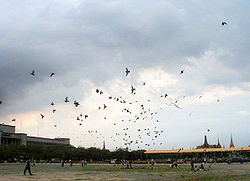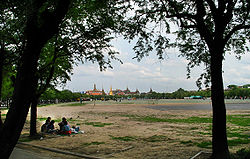
Sanam Luang
Encyclopedia

Wat Phra Kaew
The Wat Phra Kaew is regarded as the most sacred Buddhist temple in Thailand. It is a "potent religio-political symbol and the palladium of Thai society". It is located in the historic centre of Bangkok , within the precincts of the Grand Palace.The main building is the central ubosoth, which...
and the Grand Palace, Bangkok
Bangkok
Bangkok is the capital and largest urban area city in Thailand. It is known in Thai as Krung Thep Maha Nakhon or simply Krung Thep , meaning "city of angels." The full name of Bangkok is Krung Thep Mahanakhon Amon Rattanakosin Mahintharayutthaya Mahadilok Phop Noppharat Ratchathani Burirom...
, Thailand
Thailand
Thailand , officially the Kingdom of Thailand , formerly known as Siam , is a country located at the centre of the Indochina peninsula and Southeast Asia. It is bordered to the north by Burma and Laos, to the east by Laos and Cambodia, to the south by the Gulf of Thailand and Malaysia, and to the...
. Sanam Luang is located in the Phra Nakhon
Phra Nakhon
Phra Nakhon is one of the 50 districts of Bangkok, Thailand. It is the central district of Bangkok, including the Rattanakosin Island...
district, the historic center of Bangkok.
It was written in the Royal Chronicle as follow that : "In front of Wat Mahathat
Wat Mahathat
Wat Mahathat is the common short name of several important buddhist temples in Thailand. The name may refer to:* Wat Mahathat Yuwarajarangsarit , Bangkok...
, Sanam Luang lies between the Royal Palace
Grand Palace, Bangkok
The Grand Palace is a complex of buildings in Bangkok, Thailand. It served as the official residence of the Kings of Thailand from the 18th century onwards. Construction of the Palace began in 1782, during the reign of King Rama I, when he moved the capital across the river from Thonburi to Bangkok...
and the Palace to the Front. When royal cremation was held at the Phramen Ground, the pyre set up in the centre with the Royal Palace Pavilion to the south and the one of the Prince of the Palace to the Front to the north. The music from the Royal Palace and from the Palace to the Front would be played on opposite sides of Sanam Luang".
Sanam Luang was officially known as Thung Phra Mane (the royal cremation ground) (Thai : ทุ่งพระเมรุ). It has been used as a site for the cremation of kings, queens and high-ranking princes since the reign of King Rama I.
In 1855, King Rama IV
Mongkut
Phra Bat Somdet Phra Poramenthramaha Mongkut Phra Chom Klao Chao Yu Hua , or Rama IV, known in foreign countries as King Mongkut , was the fourth monarch of Siam under the House of Chakri, ruling from 1851-1868...
changed the name from Thung Phra Mane to Thong Sanam Luang , but the name is now shortened to Sanam Luang.
History

Buddha Loetla Nabhalai
Phra Bat Somdet Phra Poramenthramaha Isarasundhorn Phra Buddha Loetla Nabhalai , or Rama II , was the second monarch of Siam under the House of Chakri, ruling from 1809-1824. In 1809, Isarasundhorn succeeded his father Buddha Yodfa Chulaloke, the founder of Chakri dynasty, as Buddha Loetla Nabhalai...
followed this example of performing royal ceremonies there, including the cremation of the Prince of the Palace to the Front of his reign, who was also his beloved brother. The Royal Chronicles mention the close link between the two brothers as follows :
"At the beginning of the season of the tradewind
Tradewind
A trade wind is a wind pattern. Trade Wind or Tradewind can also refer to:* Trade Winds, 1938 film directed by Tay Garnett* Trade Wind, alternate name for the 1998 film At Sachem Farm* Trade Wind, a book by M. M...
, the king flew a Chula kite (star-shaped kite) in front of the Temple of the Emerald Buddha
Wat Phra Kaew
The Wat Phra Kaew is regarded as the most sacred Buddhist temple in Thailand. It is a "potent religio-political symbol and the palladium of Thai society". It is located in the historic centre of Bangkok , within the precincts of the Grand Palace.The main building is the central ubosoth, which...
and the Prince of the Palace to the Front flew a Pakpao kite (plain kite) at Sanam Luang".
During the reign of King Rama III, when Thailand was engaged in a conflict with Vietnam
Vietnam
Vietnam – sometimes spelled Viet Nam , officially the Socialist Republic of Vietnam – is the easternmost country on the Indochina Peninsula in Southeast Asia. It is bordered by China to the north, Laos to the northwest, Cambodia to the southwest, and the South China Sea –...
over the Cambodia
Cambodia
Cambodia , officially known as the Kingdom of Cambodia, is a country located in the southern portion of the Indochina Peninsula in Southeast Asia...
n border, the King wished to demonstrate to other nations that Thailand was such a fertile, flourishing country that even the area in front of the Grand Palace was cultivated. Sanam Luang was then a normal plot of land, used for growing rice. When there was a Royal Funeral, it would be smoothed over to prepare for the event.
King Rama IV
Mongkut
Phra Bat Somdet Phra Poramenthramaha Mongkut Phra Chom Klao Chao Yu Hua , or Rama IV, known in foreign countries as King Mongkut , was the fourth monarch of Siam under the House of Chakri, ruling from 1851-1868...
set up a place for performing the Royal Ploughing Ceremony
Royal Ploughing Ceremony
The Royal Plowing Ceremony is an ancient royal rite held in Cambodia and Thailand to mark the traditional beginning of the rice-growing season...
and the Ceremony of Calling the Rain (Thai พระราชพิธีพืชมงคลจรดพระนังคัลแรกนาขวัญ) where low walls were put up and a small hall was built to place the Buddha image for the Ceremony. Pavilions and towers were built near the king's seat when he watched the ploughing ceremony. Next to the king's pavilion there was a stage where plays were performed as part of the ritual of propitiating the gods. Outside the wall there was a barn where the rice would be stored.
King Rama V enlarged Sanam Luang and pulled down all the buildings which were used for the ceremonies of former kings and it was no longer necessary to grow rice near the Royal Palace. The space was needed for the preparation of the Centennial Celebration of Bangkok in 1897 which took place soon after King Rama V's return from Europe. It was a grand celebration also corresponding to the king's fiftieth birthday. Sanam Luang was still the place for kite flying. King Rama VI again used the place in the same manner as former kings to perform various ceremonies. Also, it was used as a race-track, and golf-course since more foreigners came to visit and stay in the country.
.jpg)
Ramphaiphanni
align=right|Queen Rambhai Barni of Siam , formerly Her Serene Highness Princess Rambhai Barni Svastivatana , was the wife and Queen Consort of King Prajadhipok of Siam.-Early life:...
of King Rama VII
Prajadhipok
Phra Bat Somdet Phra Poramintharamaha Prajadhipok Phra Pok Klao Chao Yu Hua , or Rama VII was the seventh monarch of Siam under the House of Chakri. He was the last absolute monarch and the first constitutional monarch of the country. His reign was a turbulent time for Siam due to huge political...
, in 1986.
The last cremation that took place there was for the King Rama IX's sister, HRH Princess Galyani Vadhana Krom Luang Naradhiwas Rajanagarindra
Galyani Vadhana
Her Royal Highness Princess Galyani Vadhana, the Princess of Naradhiwas , was a princess of Thailand and the elder sister of King Ananda Mahidol and King Bhumibol Adulyadej...
in 2008.
The Fine Arts Department has listed Sanam Luang as a historical site in 1977, announced on 13 December 1977, according to the Royal Decree (book 94 part 126). The area of Sanam Luang is about 30 acres (74 Rai 63 Wa).

